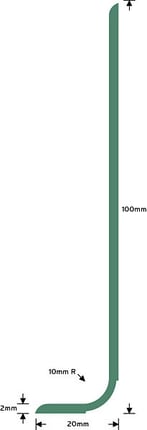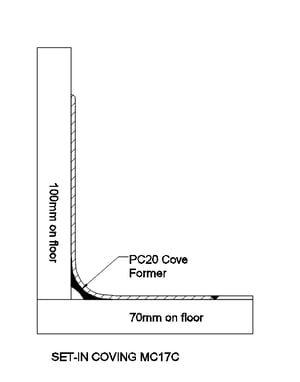Denver Coleman, Chairman of Polyflor SA, highlights the finishing profiles needed for vinyl installations, and how they would affect hygiene and maintenance of the installation.
There are several finishing extrusions available for contract use with vinyl sheet flooring. Below are some explanations on the different profiles available, what their differences are, and where to use them:

Standard sit-on skirting is a surface, glue-on type of profile and has been used for many years. This type of skirting is particularly suitable for regular, non-wet or health-type areas. It is easy to install, and comes in a variety of sizes with a variety of foot widths. However, it is important to bear in mind that the wider the foot, the more difficult it can be to get a good corner join on the floor.
In healthcare situations this type of skirting can possibly harbour germs as it has a ledge or tapered edge at the top.
Set-in skirting is a much safer option to consider in healthcare or hygienic installations, as it is welded in situ to the floor sheeting. If hygiene is of paramount importance, this is a good option as only the top taper edge leaves any space where possible germs and dirt could be harboured. Due to the foot size, installation quality is important and good-quality installers are required.

A cove former is used to cove the sheeting up the wall and, together with the capping strip, will give the most hygienic finish.
The radius of the cove former is quite critical, as the smaller radius (minimum down to 20mm) will almost eliminate the possibility of the floor sheeting cracking on the cove – as long as both products are correctly installed. A 20mm cove is also sufficient in avoiding dirt collection in the cove, and in avoiding the floor scrubbers from damaging it.
Expansion joint covers

There are a variety of different expansion joint covers available on the market, the most common being a vinyl cover that has a concertina section in the middle to allow for some expansion. The sides are tapered, and can be welded to the vinyl sheeting, giving it a seamless look.
This profile, EJC65, will typically allow 0-5 mm of expansion/movement. Expansion joint covers should always be installed using a good-quality contact adhesive on both sides of the expansion joint, giving it a secure bond. Allow for some amount of expansion in the ribbed/concertina part of the product.
There are detailed data sheets from the manufacturers on this type of product, however the general rules are as follows:
If the joint is a proper construction joint, then the correct installation method needs to be followed:
- Waterproof the joint – (polysulphide compound is often used).
- Support the joint cover. Hardboard or readily available bulletin board can be hammered into the join, alternatively a cork-type product can also be used on edge.
This method is for construction joint and not usually necessary for saw-cut joint.
Edging and bevel strips provide a finish in doorways and on edges where there is no vinyl. A taper to the floor level is usually required. There are a variety of different bevel strips available. Ensure that the edge is cut straight and the floor surface is clean, and clear of flooring adhesive.
Finally, it is important to investigate the type of finishing product best suited for your installation. The important considerations are your design, hygiene requirements, maintenance regime and the type of material being used.
Got a question for Denver? Ask him anything you’d like to know!
